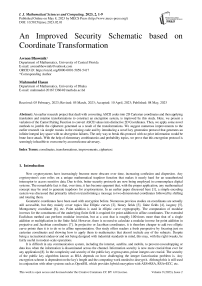An Improved Security Schematic based on Coordinate Transformation
Автор: Awnon Bhowmik, Mahmudul Hasan
Журнал: International Journal of Mathematical Sciences and Computing @ijmsc
Статья в выпуске: 2 vol.9, 2023 года.
Бесплатный доступ
An earlier research project that dealt with converting ASCII codes into 2D Cartesian coordinates and then applying translation and rotation transformations to construct an encryption system, is improved by this study. Here, we present a variation of the Cantor Pairing Function to convert ASCII values into distinctive 2D Coordinates. Then, we apply some novel methods to jumble the ciphertext generated as a result of the transformations. We suggest numerous improvements to the earlier research via simple tweaks in the existing code and by introducing a novel key generation protocol that generates an infinite integral key space with no decryption failures. The only way to break this protocol with no prior information would be brute force attack. With the help of elementary combinatorics and probability topics, we prove that this encryption protocol is seemingly infeasible to overcome by an unwelcome adversary.
Coordinates, transformations, improvements, ciphertext
Короткий адрес: https://sciup.org/15019048
IDR: 15019048 | DOI: 10.5815/ijmsc.2023.02.01
Список литературы An Improved Security Schematic based on Coordinate Transformation
- A. Bhowmik, "An encoding schematic based on coordinate transformations," International Journal of Mathematical Sciences and Computing(IJMSC), 2020.
- I. Setiadi, A. I. Kistijantoro and A. Miyaji, "Elliptic curve cryptography: Algorithms and implementation analysis over coordinate systems," in 2015 2nd International Conference on Advanced Informatics: Concepts, Theory and Applications (ICAICTA), 2015.
- D. Hankerson, J. López Hernandez and A. Menezes, "Software implementation of elliptic curve cryptography over binary fields," in International Workshop on Cryptographic Hardware and Embedded Systems, 2000.
- A. E. Cohen and K. K. Parhi, "Gpu accelerated elliptic curve cryptography in gf (2 m)," in 2010 53rd IEEE International Midwest Symposium on Circuits and Systems, 2010.
- L. De Feo, "Mathematics of isogeny based cryptography," arXiv preprint arXiv:1711.04062, vol. 12, 2017.
- T. Moriya, H. Onuki, Y. Aikawa and T. Takagi, "The Generalized Montgomery Coordinate: A New Computational Tool for Isogeny-based Cryptography," Cryptology ePrint Archive, 2022.
- M. S. Hossain, Y. Kong, E. Saeedi and N. C. Vayalil, "High-performance elliptic curve cryptography processor over NIST prime fields," IET Computers & Digital Techniques, vol. 11, p. 33–42, 2017.
- W. Diffie and M. E. Hellman, "Multiuser cryptographic techniques," in Proceedings of the June 7-10, 1976, national computer conference and exposition, 1976.
- C. E. Shannon, "Communication theory of secrecy systems," The Bell system technical journal, vol. 28, p. 656–715, 1949.
- W. Stallings, Cryptography and network security, 4/E, Pearson Education India, 2006.
- P. L. Montgomery, "A survey of modern integer factorization algorithms," CWI quarterly, vol. 7, p. 337–366, 1994.
- R. Voliansky, N. Volianska, V. Kuznetsov, M. Tryputen, A. Kuznetsova and M. Tryputen, "The Generalized Chaotic System in the Hyper-complex Form and Its Transformations," in International Symposium on Engineering and Manufacturing, 2022.
- G. Alvarez and S. Li, "Some basic cryptographic requirements for chaos-based cryptosystems," International journal of bifurcation and chaos, vol. 16, p. 2129–2151, 2006.
- S. Tedmori and N. Al-Najdawi, "Image cryptographic algorithm based on the Haar wavelet transform," Information Sciences, vol. 269, p. 21–34, 2014.
- M. Mahesh, D. Srinivasan, M. Kankanala and R. Amutha, "Image cryptography using discrete haar wavelet transform and arnold cat map," in 2015 International Conference on Communications and Signal Processing (ICCSP), 2015.
- A. Bhowmik and M. Hasan, CoordinateGeometryCrypto, 2022.


